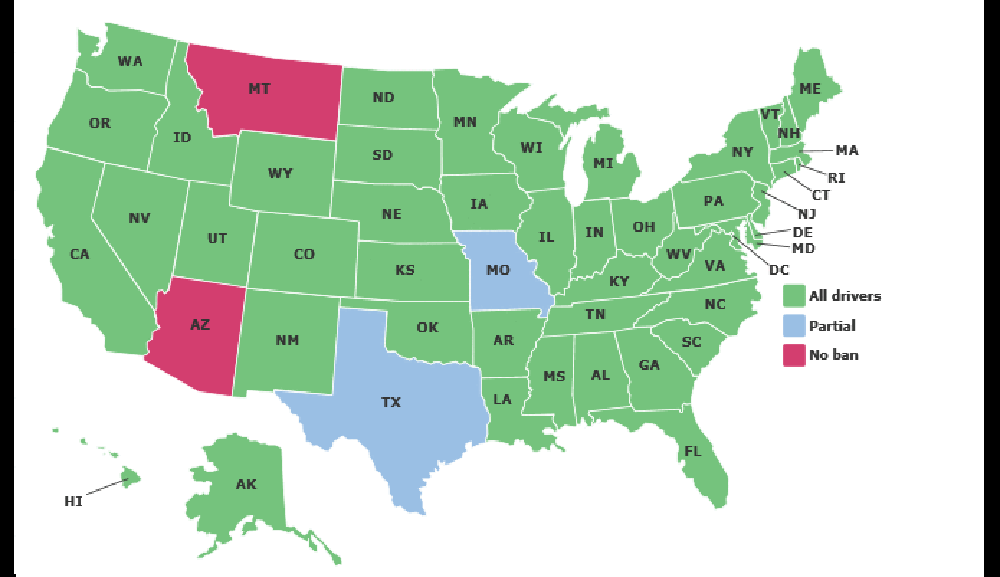Officers turn to unusual tactics to enforce texting-while-driving bans
Published 12:00 pm Friday, October 30, 2015

- Where is texting-while-driving banned?
If you got busted by one of Cpl. Patrick Robinson’s fellow officers, it might be because you didn’t read his sign: “I am not homeless. I am a Montgomery County Police Officer looking for cell phone texting violations.”
Robinson went undercover dressed as a homeless man in Montgomery County, Maryland — a tactic that’s been getting lots of attention online and on social media — as part of the police department’s enforcement against a growing number of dangerous, distracted drivers.
Trending
While state officials have said a ban on texting and driving saves lives, the actual enforcement of it has been a difficult assignment.
According to the Governors Highway Safety Association, Washington was the first state to pass a texting ban in 2007. Currently, 46 states, D.C., Puerto Rico, Guam and the U.S. Virgin Islands ban text messaging for all drivers. And all but five have primary enforcement, allowing officers to issue a citation when they see a driver texting regardless of other infractions.
Where is texting and driving banned?
– California drivers who are 18 and older may dictate, send or listen to text-based messages if they’re using voice-activated, hands-free devices.
– Missouri’s partial ban is for drivers 21 and younger.
Trending
– Drivers in school crossing zones and on public property during the time the reduced speed limit applies, bus driver with minor passengers and drivers younger than 18 are all covered by Texas’ partial ban.
Officer George Tyson of the Pooler, Georgia, Police Department told Live 5 how he once thought he caught a driver using their phone to text while they were driving. When he pulled the woman over, and explained why he had stopped her, she told him she wasn’t texting.
“She says it was a GPS and she showed it to me. Using GPS is not against the law, even if it is on the cellphone,” Tyson said. “You have to catch them when they are doing it. I’m looking for the hands on the steering wheel. See if I can see a cell phone or they are punches keys on a key pad.”
Despite Robinson’s warning sign, when drivers stopped at the intersection where he was stationed and pulled out their phones to text at the stoplight, the disguised officer called in uniformed officers, who were waiting close by.
According to Montgomery County Sgt. Phillip Chapin, his officers issued 31 tickets and nine warnings to people caught using their phones without hands-free devices.
According to Centers for Disease Control, each day in the United States, more than nine people are killed and more than 1,153 people are injured in crashes that are reported to involve a distracted driver. In 2012, 3,328 people were killed in crashes involving a distracted driver, compared to 3,360 in 2011. An additional, 421,000 people were injured in motor vehicle crashes involving a distracted driver in 2012, a 9 percent increase from the 387,000 people injured in 2011.
Chapin said more and more of wrecks caused by distracted drivers involved people using their phones.
“We’re seeing more and more, as we pull cell phone records, that they’re distracted driver-related deaths because they will not put their phones down,” Chapin said.
In Oklahoma, texting and driving will result in a $100 fine beginning Sunday when the Trooper Nicholas Dees and Trooper Keith Burch Act of 2015 takes effect. Claremore, Oklahoma Police Chief Stan Brown said the new law will give officers an opportunity to educate the public on the dangers of texting and driving.
“As everyone knows, and we want to emphasize, texting is distracted driving and causes accidents,” Brown told the Claremore Daily Progress. “That is proven. Our approach will be to follow the letter of the law. If we determine a person is composing, sending or reading a text message we will use the opportunity for a traffic stop and utilize the new law to change those folks’ behavior.”
However, in Enid, Oklahoma, the law is not enough for city officials. They approved an emergency ordinance that will make it possible for Enid Police Department to enforce a state law banning texting while driving.
“We would not write (a state citation) for texting. We’d like to have a state or a city ordinance for that, which we should be able to get fairly quick,” Enid Police Chief Brian O’Rourke told the Enid News. “Now, we could make an arrest on that, yes. But, more than likely, say there’s an accident or a DUI when somebody was texting, there would be a secondary included and we would arrest for it. But to pull somebody over for texting and driving and arrest them and do all that associated paperwork for … $100 … that’s sort of tough. That would tie up a lot of officers’ time and energy to do that. We would rather be in the position to write a citation in a two-minute traffic stop, considering this is going to be a primary offense now.”
Yet, while Oklahoma drivers drivers are allowed to text when the vehicle is not in motion, such as while waiting on a red light, other states have prohibited that act also. Because the laws are different for each state, that can cause uncertainty for the drivers and those who’s job it is to enforce the laws.
“You cannot text while driving, you cannot have your phone in your hand while you’re driving, you cannot have the phone to your ear while you’re driving,” Chapin said.
The Enid News & Eagle and Claremore Daily Progress contributed to this story.


